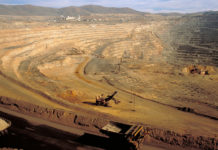
[miningmx.com] – GOLD Fields is to make a decision by the end of 2015 or in 2016 whether to shut its Darlot mine which was acquired as part of the Yilgarn assets the firm bought from Barrick Gold in 2013 for about $300m.
Responding to questions in a presentation to analysts, Gold Fields CEO, Nick Holland, said Darlot was always “a short life operation”. Whilst there were some encouraging exploration results at the Australian mine it was “too early to be sure”.
“We said that we would give it the best possible chance to find additional life at depth. There are some encouraging drill results coming through. There might be an analogue of what we have mined over the last 15 years at depth,” said Holland.
“We will have to make a call on Darlot during the course of late 2015 or early 2016. So that might be a casualty in the group as well,” he said.
Gold Fields had also received interest in its other two remaining non-core assets: the Arctic Platinum Project in Finland, and the Woodjam copper-gold project in British Columbia. “So those are on the block, as it were, and we have had some interest in that but we don’t have anything definitive,” said Holland.
“But other than that, everything else in the portfolio we believe is core and can add to the vision,” he added.
Holland also said that although analysts were applying a higher discount rate in their valuations of South African gold companies, the strong performance of Gold Fields’, and Sibanye Gold’s share last year proved that good ratings were still possible.
“I think it tells me that if you can generate the cash flow, if you can adhere to your promises and deliver, I think you will get the rating irrespective of where we are,” said Holland.
“So I don’t necessarily think it is about domiciles or assets and where they are. If those assets deliver and those assets perform you will get the rating,” he said.
On May 7, Gold Fields reported a $14m net loss for the March quarter which featured a hefty 25% decline in output from its mechanised South African mine, South Deep. The performance precipitated a 14% one day decline in its share price.
The company’s share price subsequently fell to a 12 month low of R43,59 on May 12 before recovering slightly to its current level of about R45/share. It wasn’t alone, however, as there was a sector-wide liquidation during that period with Sibanye Gold particularly hit hard.









